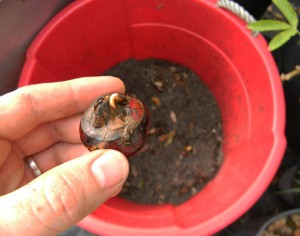What if I told you there was a way to grow a few thousand calories in a kiddie pool?
“What? In a kiddie pool? You mean, like, eating tadpoles, right?”
No. Not eating tadpoles. That’s gross.
I’m talking about another plant: the Chinese Water Chestnut. Known in Latin as Eleocharis dulcis, Chinese water chestnuts are NOT the same as the invasive “water chestnut” that’s invaded our native wetlands. Chinese water chestnuts are a member of the sedge family and look like a 2-4′ tubular grass. They love to grow in muck or shallow water. At the end of their growing season, at the base of the reedy growth under a mat of roots, you’ll find the edible corms, or “chestnuts.”
These roots have a crisp, nutty flavor that’s delicious – but you’d have to ask a lot of folks before you found a person who has tasted them. They’re almost an unknown vegetable here in the United States.
I looked around for Chinese Water Chestnuts for quite a long time. It took me almost three years to find my first few corms. I finally got them in the spring one year, popped them in some muck in the bottom of a bathtub and waited.
The growth of these puppies was ridiculous. I planted six corms and they completely filled that bathtub with reeds. When fall came, I harvested at least a gallon of water chestnuts. From my reading, it seems I would have harvested a lot more – and larger – corms if the tub wasn’t so crowded. I’ve since found that it would’ve only taken one plant to fill up that bathtub with reeds and tasty roots.
This spring I decided to grow Chinese Water Chestnuts in kiddie pools. Though they’re not supposed to be cold-hardy, I found that the roots didn’t freeze in the bottom of my first bathtub garden and were still viable in the spring. I now have four kiddie pools filled with Water Chestnuts, plus a second bathtub and a small in-ground pond. I also had enough Chinese Water Chestnuts left over from last year that I was able to give some to a couple of friends with ponds.
Growing them in kiddie pools is easy. You just fill the pools most of the way to the top with muck and plant. Chinese water chestnuts don’t need to be covered in water; all they need is to be in boggy conditions. (Now is the time of year to find kiddie pools since they’re usually on clearance!)
Chinese Water Chestnuts are probably perennial in USDA Growing Zones 8 south. If you protect them, they’ll go further north than that.
You can get corms and live plants from my nursery or check your local Oriental market for fresh roots. They’ll sometimes have them.
To grow Chinese water chestnuts, plant corms a couple of inches deep in mucky soil or at the edge of a pond and stand back. They grow quickly and will rapidly spread to fill whatever space you give them. Let them grow until the tops start to yellow and die back, then start digging. Be gentle as you harvest: the skins on Chinese water chestnuts are somewhat easy to damage and the roots won’t keep as long if they’re scratched. As for storage, you can put the corms in a container of water or moist paper towels and refrigerate them until you need them… they keep quite well. Peel, slice and eat them raw or cooked. They keep their crunch even after cooking, adding a great texture to stir-fries and other dishes.
As for nutrition and calories, Chinese Water Chestnuts ain’t half bad. Check out this overview from SELFNutritionData:
As for nutrition and calories, Chinese Water Chestnuts ain’t half bad. Check out this overview from SELFNutritionData:
Pretty good for something that requires basically no work to grow. I’m working towards making Chinese Water Chestnuts a staple crop on my homestead.
My friend Kathy in Georgia also reported that her Chinese Water Chestnuts were doing excellently up there. In two months she went from this:
To this:
I’ll have to find out how she does overwintering her plants. I have been able to keep dormant corms in a bucket of fresh water for a month in the kitchen without them dying but I don’t know how they’ll do long-term. Refrigeration in damp peat/perlite might be an option.
The roots are tasty, the yields are good, and they don’t require much watering other than insuring the muck doesn’t dry out.
The best thing? They taste great. The flavor is slightly sweet, nutty and refreshing. Not bad for something that’s almost work-free.
If you try growing Chinese Water Chestnuts, let us know – any reports on this overlooked root would be appreciated.





I have a lot of marsh land will have to try this there.
Any ideas on how to preserve them for long term storage? Not for growing, but just for eating… I’d keep just one or two to grow each year and preserve the rest…